To check transmission fluid, warm up the vehicle, park on a level surface, locate the dipstick, remove it, wipe clean, reinsert, then check the fluid level and color.
Introduction
The transmission is one of the most crucial components in any vehicle, acting as the bridge between the engine and the wheels. It ensures the engine’s power is transmitted efficiently, allowing the car to move and perform at its best. Transmission fluid plays a vital role in making sure this process happens smoothly. It’s not just about lubrication; it’s about keeping your vehicle running optimally.
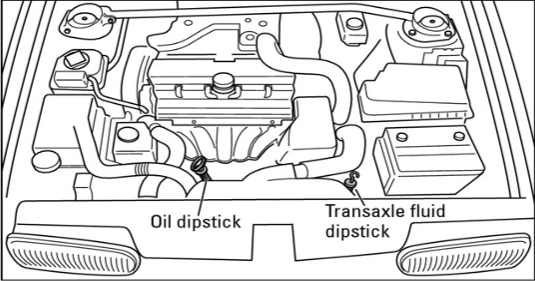
Importance of Transmission Fluid
Transmission fluid serves several essential functions:
- Lubrication: It reduces friction between the transmission’s moving parts, ensuring they don’t wear out prematurely.
- Cooling: As transmissions work, they generate heat. The fluid helps dissipate this heat, preventing overheating and potential damage.
- Power Transmission: The fluid acts as a hydraulic fluid, helping to transmit power from the engine to the wheels.
- Protection: It protects against metal-to-metal contact, rust, and oxidation, ensuring a longer lifespan for the transmission components.
A well-maintained fluid level ensures your transmission runs smoothly, reducing the risk of costly repairs in the long run. For more details on transmission fluid and its significance, you might want to refer to its Wikipedia page.
Types of Transmission Fluids
There are various types of transmission fluids available, each formulated to meet specific requirements:
- Dexron/Mercon: These are the most common types of transmission fluids and are primarily used in GM and Ford vehicles.
- Hypoid Gear Oil: Typically used in manual transmissions, this fluid is thicker and is designed to handle the high pressures of gear engagements.
- Synthetic Oil: This type of fluid is chemically engineered to provide the smoothest shifting and is resistant to high temperatures.
- Type F: A specific fluid mainly used in older Ford vehicles.
- Continuously Variable Transmission (CVT) Fluid: Designed exclusively for CVT transmissions, this fluid ensures seamless power delivery.
Choosing the right fluid for your vehicle is essential. Always consult your vehicle’s manual or a mechanic to ensure you’re using the correct type. For a more in-depth look at the different types of transmission fluids, check out their Wikipedia page.
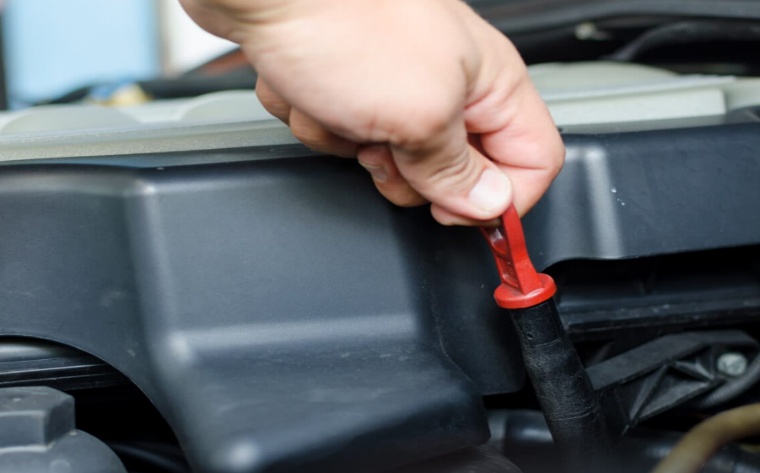
Safety Precautions
Whenever you’re working with a vehicle, especially components as vital as the transmission, safety should always be the top priority. Taking preventive measures ensures not only your safety but also the proper functioning of your vehicle. Before diving into the procedures, it’s essential to understand and prepare the tools you’ll need and to be aware of personal safety measures to adhere to.
Tools and Equipment Needed
To check your transmission fluid safely and efficiently, you’ll require specific tools and equipment:
- Dipstick: Most vehicles have a transmission fluid dipstick, typically separate from the engine oil dipstick. Ensure you’re using the correct one.
- White Rag or Paper Towel: To wipe off the fluid from the dipstick and check its color.
- Funnel: If you need to add or replace the fluid, a funnel will ensure no spillage.
- Gloves: To protect your hands from any contaminants and to keep them clean.
- Safety Glasses: Protects your eyes from any accidental splashes.
- Flashlight: Helpful if the dipstick location is not well-lit or if checking under the vehicle.
For more details on automotive tools and their usage, consider visiting the Wikipedia page on automotive tools.
Personal Safety Measures
When checking transmission fluid, or working on a vehicle in general, adhere to these safety guidelines:
- Work in a Well-Ventilated Area: Ensure you’re in a spacious and well-ventilated area to avoid inhaling harmful fumes.
- Avoid Smoking: Transmission fluid is flammable. Keep away from open flames.
- Wear Protective Gear: Always use gloves and safety glasses to protect yourself.
- Vehicle Position: Ensure the vehicle is on a flat surface and the parking brake is engaged.
- Avoid Hot Surfaces: Be careful when working around the engine and transmission, as components can get extremely hot and cause burns.
- Dispose of Fluid Properly: If you’re changing the fluid, ensure you dispose of the old fluid at a designated disposal facility or recycling center.
Remember, safety first. It’s always better to take a few extra precautions than risk injury. For more on general automotive safety, you can refer to the Wikipedia page on car safety.
Preparation Steps
Before delving into the actual process of checking the transmission fluid, proper preparation is paramount. These preparatory steps ensure the most accurate reading of the fluid level and condition, and they help ensure safety during the procedure. Let’s look into the essential preparation steps.
Locating the Transmission Dipstick
The transmission dipstick is your primary tool for assessing the fluid level and its condition. Here’s how to locate it:
- Refer to the Owner’s Manual: Your vehicle’s manual will typically have a diagram or description indicating the dipstick’s location. If you’ve misplaced your manual, many are available online or through the manufacturer’s website.
- Engine Compartment: Most commonly, the transmission dipstick is located in the engine compartment. It often has a handle labeled “transmission” or has an image indicating its function.
- Distinct from Engine Oil Dipstick: Ensure you’re not confusing it with the engine oil dipstick. The transmission dipstick is sometimes longer and might have a different color handle.
- Front-Wheel Drive vs. Rear-Wheel Drive: In front-wheel-drive vehicles, the dipstick is usually located towards the front of the engine. In rear-wheel-drive vehicles, it’s typically towards the rear.
To understand more about vehicle components and their locations, here’s a handy Wikipedia page on automotive design.
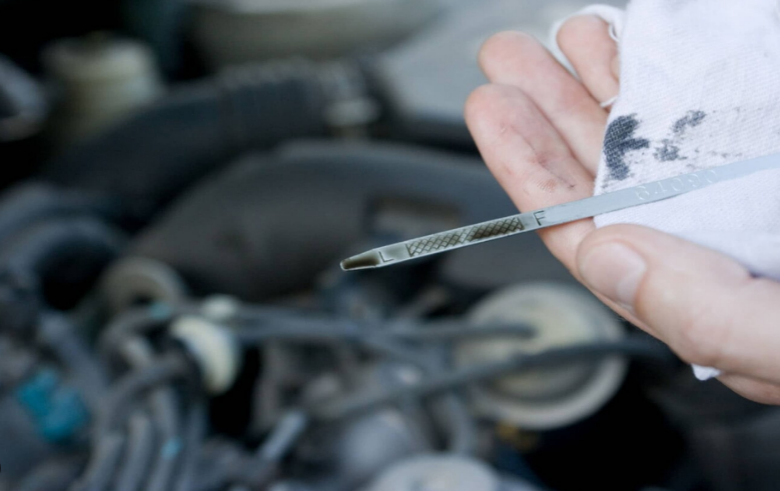
Setting up Proper Vehicle Conditions
The accuracy of your transmission fluid check can be influenced by various factors:
- Parking: Park your vehicle on a flat, level surface to ensure an accurate reading. Engage the parking brake for added safety.
- Engine Temperature: For most vehicles, the engine should be at its operating temperature, meaning it’s best to check the fluid after a short drive. However, some vehicles may require a cold engine, so always refer to your owner’s manual.
- Engine Status: Keep the engine running during the check unless your manual suggests otherwise.
- Gear Position: For automatic transmissions, it’s best to be in the ‘Park’ or ‘Neutral’ position. For manual transmissions, ensure the gear is in neutral.
- Wait Time: If you’ve just turned off a hot engine, wait a few minutes to allow the transmission fluid to settle.
Once these conditions are met, you’re ready to proceed with the fluid check. For a deeper understanding of how vehicle conditions can affect different checks and measures, consider browsing the Wikipedia page on automotive engineering.
Checking Transmission Fluid Level
Assessing the transmission fluid level is pivotal to maintaining the optimal performance and longevity of your transmission system. An accurate reading can provide insights into potential issues and prevent costly damages. Let’s guide you through the steps.
Removing and Cleaning the Dipstick
Before you can gauge the fluid level, you must first remove and clean the dipstick:
- Grasp the Handle: Firmly hold the handle of the dipstick and pull it out slowly. Ensure you pull it out entirely to get a comprehensive reading.
- Clean the Dipstick: Using a white rag or paper towel, wipe the fluid off the dipstick. This step ensures you get a clear and accurate reading when you re-insert it.
- Inspect for Debris: While cleaning, check the dipstick for any debris or particles. This could indicate internal wear or contamination.
For insights into the importance of maintaining cleanliness in automotive processes, you can refer to this Wikipedia page on automotive maintenance.
Reading the Fluid Level
With a clean dipstick, you’re set to assess the fluid level:
- Reinsert the Dipstick: Place the dipstick back into its tube, ensuring you push it all the way in.
- Remove and Check: Pull out the dipstick once more and examine where the fluid reaches. There will typically be markers indicating “Low” and “Full” or similar terms.
- Fluid Position: The fluid should ideally be between these markers. If it’s closer to “Low”, you might need to add some fluid.
To understand more about how fluid levels impact vehicle systems, consider visiting the Wikipedia page on fluid dynamics for a broader perspective.
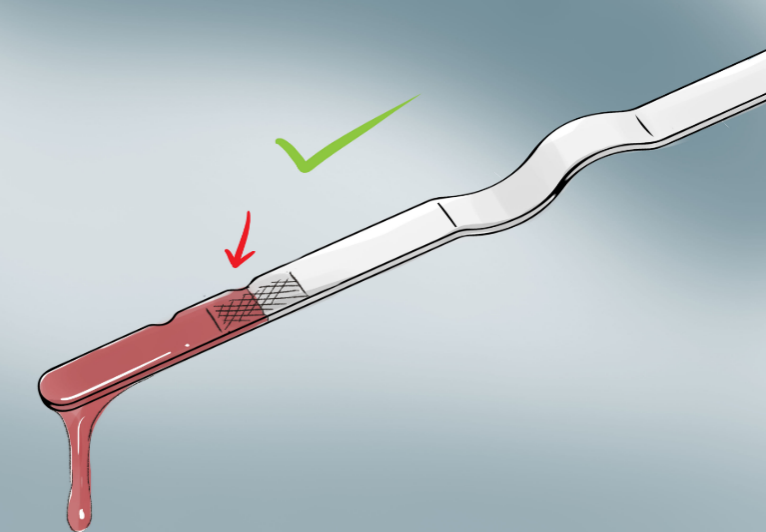
Interpreting the Results
Reading the fluid level is one aspect; interpreting the results is equally crucial:
- Optimal Level: If the fluid is between the markers, your transmission fluid level is satisfactory.
- Low Level: A level closer to the “Low” marker indicates a need for additional fluid or a potential leak in the system.
- High Level: If the fluid exceeds the “Full” marker, it can lead to frothing, which affects the transmission’s efficiency. You might need to drain some fluid in this case.
- Fluid Color: Fresh transmission fluid is typically translucent red. If the fluid appears brownish or has a burnt smell, it may be time for a change.
- Fluid Consistency: If the fluid feels gritty or has visible particles, this might indicate internal wear or the need for a fluid change.
For deeper insights into how fluids and their properties can influence machinery, this Wikipedia page on fluid mechanics offers an excellent overview.
Assessing Fluid Condition
While the fluid level gives a hint about the quantity, assessing the condition of the transmission fluid provides vital insights into its quality. The fluid’s condition can indicate the health of the transmission and determine if it’s time for a change. Let’s break down the different aspects to examine.
Color and Clarity of the Fluid
The color and clarity of the fluid are primary indicators of its health:
- Fresh Fluid: New transmission fluid is usually a translucent and bright red. It’s clear, allowing you to see through it easily.
- Aging Fluid: Over time, the fluid might turn to a darker shade of red or even brown. While this indicates it’s aging, it doesn’t necessarily mean it’s bad. However, a change might be due soon.
- Bad Fluid: If the fluid becomes a dark brown or black, it’s a clear sign that the fluid is no longer in optimal condition and should be replaced.
For a broader understanding of how colors can indicate the quality of automotive fluids, you might find this Wikipedia page on chromatics insightful.
Smell Test for Burnt Fluid
The odor of the transmission fluid can also offer crucial information:
- Normal Odor: Fresh transmission fluid has a mild petroleum smell, which is typical and not cause for concern.
- Burnt Odor: If the fluid emits a burnt smell, it’s a sign of overheating or that the fluid has deteriorated. This condition can lead to inefficient lubrication and potential damage to the transmission. In such cases, a fluid change is recommended.
A deeper dive into how smells are detected and their significance in various industries can be explored on this Wikipedia page about olfaction.
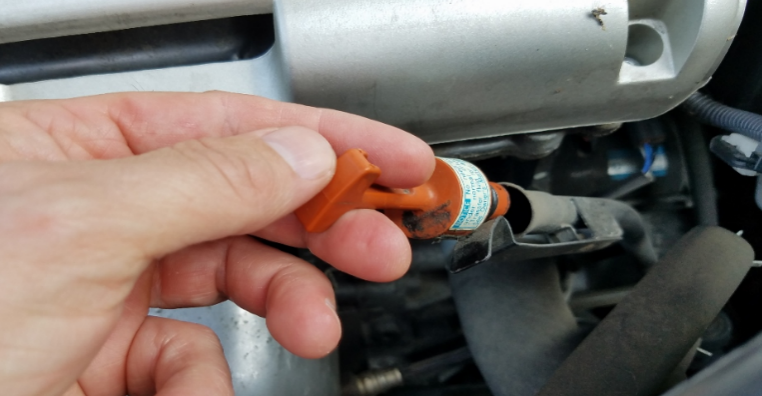
Checking for Contaminants
Contaminants in the fluid can be a sign of internal issues:
- Visual Inspection: Hold the dipstick against a white rag or paper towel. If you see particles or debris in the fluid, it might be a sign of internal wear or contamination.
- Feel Test: Rub the fluid between your fingers. If it feels gritty, it might contain contaminants, suggesting potential internal wear.
- Common Contaminants: Metal shavings, dirt, or other foreign particles can indicate various problems, from worn-out internal components to breaches in the transmission system.
For further reading on contaminants and their effects on machinery, this Wikipedia page on contamination control offers a comprehensive overview.
What to Do if Fluid is Low or Contaminated
Recognizing a problem with the transmission fluid is only half the battle. Addressing the issue promptly can prevent further damage and ensure the longevity of the transmission system. Whether the fluid is low or contaminated, there are specific measures to consider.
Procedures to Top Off Fluid
If you find the transmission fluid to be on the lower side:
- Check the Manual: Always refer to the owner’s manual to identify the specific type of transmission fluid your vehicle needs.
- Clean Funnel: Use a clean funnel to add the fluid, ensuring there’s no contamination.
- Add Gradually: Pour the fluid slowly, checking the level periodically to avoid overfilling.
- Run the Vehicle: After topping off, run the vehicle for a few minutes, shifting through all gears. This helps circulate the fluid and then recheck the level to ensure accuracy.
For deeper insights into topping off fluids and their significance in vehicles, this Wikipedia page on automotive maintenance can be a useful resource.
When to Change Transmission Fluid
Recognizing when to change the fluid is essential:
- Routine Maintenance: Generally, a transmission fluid change is recommended every 30,000 to 60,000 miles, but always refer to your vehicle’s manual for specific intervals.
- Signs of Wear: Dark brown or black fluid, a burnt smell, or the presence of contaminants all signal that a change might be due sooner than the typical maintenance schedule suggests.
- Driving Conditions: Vehicles frequently driven in heavy traffic, rough conditions, or used for towing might need more frequent fluid changes.
More details about the importance of routine maintenance can be found on this Wikipedia page about preventive maintenance.
Considering a Transmission Flush
A transmission flush is a more intensive process than a simple fluid change:
- What It Does: A transmission flush removes all the old fluid, contaminants, and sludge, replacing it with new fluid.
- When to Consider: If the fluid is heavily contaminated or if there are shifting problems, a flush might be beneficial. However, it’s a procedure that’s not always necessary unless there are specific issues.
- Professional Help: Due to the complexity and potential risks, it’s recommended to seek professional assistance for a transmission flush.
For a broader perspective on the transmission flush procedure and its effects, you might find this Wikipedia page on automotive repair informative.
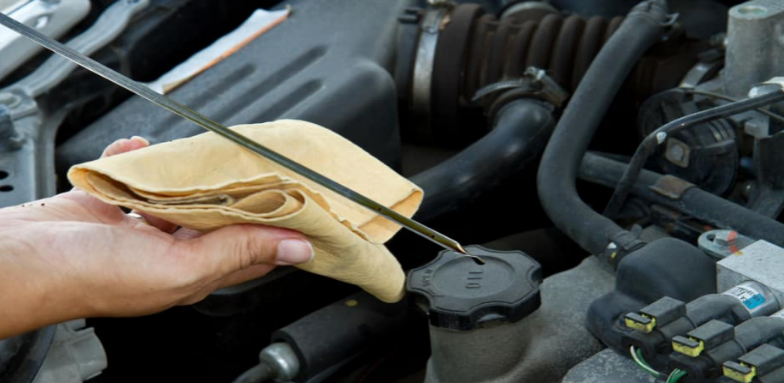
Understanding the Differences between Manual and Automatic Transmission Fluid Checking
Both manual and automatic transmissions are pivotal components in vehicles, yet they operate differently and have unique requirements. Checking the fluid for each involves nuances that one should be aware of to ensure accurate readings and appropriate maintenance.
Specifics for Manual Transmissions
Manual transmissions, also known as stick-shifts, provide a distinct driving experience and have their own fluid checking specifics:
- Location: Unlike automatic transmissions that usually have a readily accessible dipstick, manual transmissions might require checking the fluid under the vehicle, using a plug on the transmission itself.
- Fluid Type: The fluid used in manual transmissions often differs from automatic ones. They might use a heavier oil, sometimes referred to as gear oil.
- Checking Interval: While automatic transmission fluid is typically checked more frequently, manual transmission fluid doesn’t need to be checked as often. Still, it’s essential to consult your vehicle’s manual for guidance.
- Signs for Change: If there’s difficulty in shifting or a grinding noise, it might indicate the need to check or change the manual transmission fluid.
To dive deeper into manual transmissions and their mechanics, this Wikipedia page on manual transmissions offers extensive information.
Specifics for Automatic Transmissions
Automatic transmissions offer convenience in shifting and have their own set of fluid checking requirements:
- Dipstick Location: Automatic transmissions typically come with a dipstick in the engine compartment, making fluid checks more straightforward than manual ones.
- Fluid Type: Automatic transmission fluid (ATF) is specially designed to serve as both a hydraulic fluid and a lubricant. It often has a reddish hue.
- Checking Interval: It’s usually recommended to check the ATF every month or so, but always adhere to your vehicle’s specific guidelines.
- Signs for Change: Delayed or rough shifting, unusual noises, or slipping gears can be indicative of deteriorated ATF and might signal the need for a fluid check or change.
For an in-depth understanding of automatic transmissions and their intricacies, consider exploring this Wikipedia page on automatic transmissions.
Frequently Asked Questions (FAQs)
Navigating the intricacies of transmission fluid can lead to various questions. Here, we tackle some of the most commonly asked queries to help you better understand and maintain your vehicle’s transmission system.
How often should I check transmission fluid?
It’s recommended to check your transmission fluid level every month, especially if you drive your vehicle regularly. However, the frequency can also depend on:
- Vehicle Age: Older vehicles might require more frequent checks than newer models.
- Driving Conditions: If you often drive in challenging conditions, such as heavy traffic, mountainous areas, or towing heavy loads, more frequent checks are advisable.
- Manufacturer Recommendations: Always consult your vehicle’s manual for specific guidelines related to fluid checks.
For more insights into the general maintenance schedule of vehicles, this Wikipedia page on car maintenance can be useful.
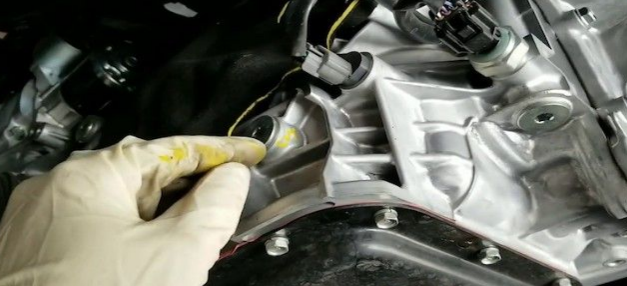
Is it bad to overfill transmission fluid?
Yes, overfilling the transmission fluid can be detrimental. Here’s why:
- Frothing: An overfilled system can lead to the fluid frothing, which can cause erratic shifting, loss of internal lubrication, and potential transmission damage.
- Overpressure: Excess fluid can increase pressure inside the transmission, leading to leaks or component damage.
- Heat Dissipation: Overfilling can also hinder the fluid’s ability to dissipate heat, increasing the chances of overheating.
Understanding the impacts of fluid dynamics in machinery, such as overfilling, can be better grasped with this Wikipedia page on fluid dynamics.
Can I use any type of transmission fluid?
No, it’s crucial to use the specific type of transmission fluid recommended for your vehicle. Here’s why:
- Compatibility: Different vehicles and transmission types have specific fluid requirements. Using the wrong fluid can cause compatibility issues, leading to inefficient operation and potential damage.
- Optimal Performance: The right fluid ensures optimal performance, smooth shifting, and prolonged transmission life.
- Manufacturer’s Recommendation: Always refer to the owner’s manual or consult a mechanic to identify the correct type of transmission fluid for your vehicle.
For a broader perspective on the different types of transmission fluids and their properties, you might find this Wikipedia page on transmission fluid insightful.
